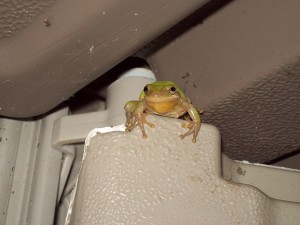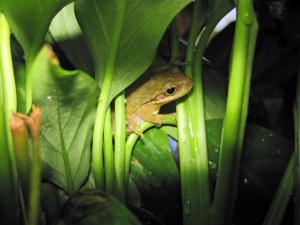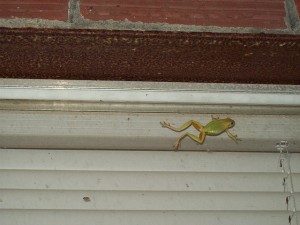The American Green Tree Frog, Hyla cinerea, is one of the most endearing amphibians that a frog lover could hope to have. Kermit the Frog was even modeled after them. Because of their ease of being kept successfully in captivity, Green Tree Frogs are often kept as pets. In the wild, they can be found thoughout much of the southeastern United States.
Description
Green Tree Frogs usually have a bright green coloration, although some may appear pale green or even yellow. Hyla cinerea are noted for having a narrow white or yellowish line that runs laterally from the snout to thigh, but in some specimens it may not be present. They range in size from 1 ¼ to 2 ½ inches in length.
Their bright green color helps them to hide successfully amid long grass stalks and palm fronds. This ability to blend into their surroundings may be their best defense from predators, although their numbers are still being significantly displaced in some areas due to the invasive Cuban Tree Frog.
The Green Tree Frog has large toe pads that allows it to stick to windows, walls, and trees while it hunts for food. These frogs are most often spotted lurking near porch lights or on light colored walls where they lie in wait for prey. Tree Frogs are voracious predators and will devour almost any insect that comes near.
Breeding
Breeding season lasts from May to October. The male will call to the female with a series of loud “quank, quank, quank” sounds that sound much like a cowbell, leading to such nicknames as cowbell frog, bell frog, and fried bacon frog. After mating, the female will lay between 400-600 eggs. Eggs hatch within 4-6 days and metamorphosis occurs over a period of two months.
In the absence of ponds, ditches, or other readily available water sources, the female may lay her eggs in standing water that collects in tree hollows, bromeliads, rain gutters, and ornamental fish ponds or fountains.
Outlook for the Species
Green Tree Frogs are extremely easy to care for and are often taken from the wild to be sold into the pet trade. The frogs are usually captured during the height of breeding season when they are easier to find, further impacting the species.
The most devastating predator of the Green Tree Frog includes the invasive Cuban Tree Frog, Osteopilus septentrionalus, which has impacted the native Green Tree Frog throughout much of south Florida. There are current on-going studies being conducted in the state of Florida to assess the ecological impact to the species.
Notable Frog Facts
- They have been recorded to live up to 6 years in captivity.
- The Green Tree Frog is the official state amphibian for Georgia and Louisiana.
- Also known as the “rain frog” because of its tendency to call just before and during rain.
- During mating season the male will call up to 75 times per minute.
- Tree frogs have powerful leg muscles that enable them to leap distances of 8-10 feet.



